If you’ve only got three months, this Southeast Asia itinerary will take you through the region’s best bits—both the highlights and the hidden gems.
Where to Travel in Southeast Asia for 3 Months
When you tell your friends you’re leaving to “backpack Southeast Asia,” they’ll probably envision you in harem pants, partying with fire dancers on Thai beaches.
Your parents probably think you’re off to volunteer caring for elephants or teaching Cambodian kids English. And you’re probably getting excited to break some serious boundaries—like summiting mountains, eating scorpions in night markets and practicing your meditation from temples.
The truth is that it’ll probably be an amalgamation of it all—and Southeast Asia is a sunny, culturally diverse and cheap (like really cheap) place to do it all.
When I say Southeast Asia, I’m talking specifically about Thailand, Laos, Vietnam and Cambodia. While there are other plenty of other countries in the region, there are time constraints when traveling Asia for just three months.
Meanwhile, in the “core four,” and with this Southeast Asia itinerary, you can travel freely without having to book tickets in advance.
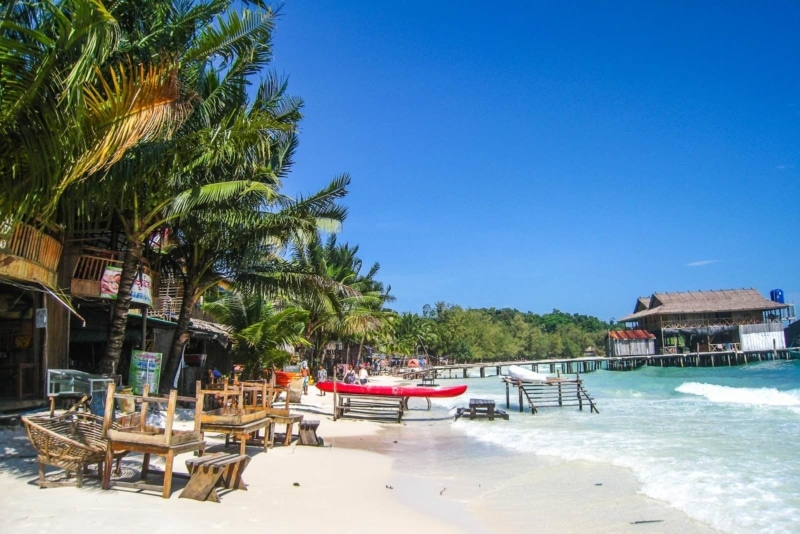
Southeast Asia is often touted as a backpacker’s haven, likely because you and other travelers are spoiled for choice when it comes to hostels. There are also clearly defined routes that run throughout the region, and most backpackers in the area are heading in the same general direction, which means making travel buddies in those hostels is easy.
There is no need for flights because day and night buses between all of these countries are simple and cheap, and hitchhiking is even common due to the population of backpackers.
And, for the more experienced backpacker who feels comfortable venturing off the beaten path, there’s more to Southeast Asia than the standard route. It’s stupidly simple to rent a motorbike for days on end and explore these countries without seeing others for days.
If you’ve only got three months, this itinerary will take you through the best bits and hidden gems.
Thailand: One Month
Thailand should be your first stop since Bangkok’s airport, Suvarnabhumi Airport, is the largest hub in and out of Southeast Asia. Most international flights will fly into there. More than 35 million people visited Thailand in 2017, which means that the country caters to tourists, and you’ll have an easier time navigating the different cities and finding accommodation in each place.
If you have never been to Asia before, Bangkok will induce serious culture shock, but embrace it; you’re not in Kansas anymore, Dorothy.
Your one month in Thailand is going to be all about visiting temple ruins, trekking through the jungles and consuming fresh, fragrant foods. You will see, hear, smell and taste things you’ve never experienced before and you will be immersed in a new and fascinating culture. Say yes to everything (except maybe “Ping Pong” shows… just trust me).
Day 1-3: Bangkok
As you travel from the airport into city (I recommend the tram) you’ll be hit with an explosion of color and sound. Multi-colored taxis honk as they swerve across five-lane highways, while motorcycles transporting entire families weave through the traffic. It’s chaos, and it’s a little overwhelming, but it’s exciting.
I have friends who have planned trips to Thailand and banked on spending a week in Bangkok at the beginning to ‘get their bearings.’ Don’t do this. Bangkok is absolutely incredible, but a week here is too long simply because there are better places to spend your time.
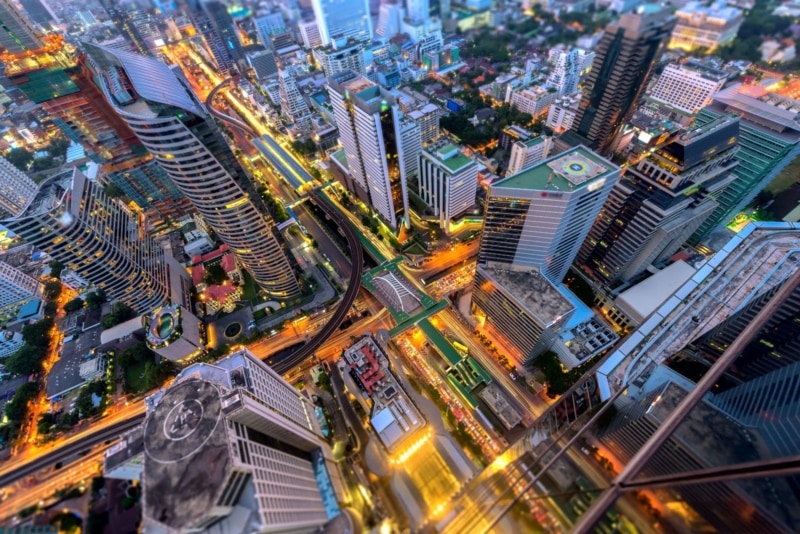
I recommend spending just a few days here exploring. You’ll want to check out the Wat Pho Temple, one of the largest temple complexes in the city known for its 151-foot-tall reclining, gold-leaf Buddha. Shopping in the Chatuchak Market could consume an entire day.
If you’re in the mood to party, spend the night bar hopping in Soi Cowboy, a street made famous by The Hangover that offers live music dive bars, clubs and go-go bars to a crowd of travelers and expatriates alike. One night should also be dedicated to Khao San Road, Bangkok’s most famous party street.
While you’re in Bangkok, it’s worth getting lost in the streets of skyscrapers to check out the hundreds of food stalls selling chicken skewers and scorpions and pla pao erupting with smells that could alone sate an appetite. There are also floating markets during the weekends and tons of biking trails to be discovered.
Day 4-11: East Coast Islands or West Coast Islands
Had your fill of the city? Now, it’s time to head south and hit Thailand’s world-renowned beaches. You can take buses and trains down south, and trains are usually more scenic. Choose either the East Coast (Koh Tao, Koh Samui, Koh Phangan) or the West Coast (Koh Phi Phi, Koh Lanta, Phuket) and island hop.
Just keep in mind that monsoon season will be affecting one side, while the other is sunny. It typically lasts from July to October and typically dominates the southwest—so if you go during those months, you may want to choose the eastern islands instead.
The islands are super simple to hop, as ferries run regularly between them for decent prices. You don’t need to plan or buy tickets in advance either.
West Coast
On the West Coast, the more famous Ko Phi Phi Leh, an island of the Phi Phi Archipelago in the Krabi Province, was made famous by Leonardo Dicaprio’s The Beach. If that’s not reason to visit, its bath-temperature waters will be begging you to swim.
But also be sure to take a day trip from one of the main islands to Koh Hai or Koh Yao Yai. These islands are far less developed than their neighbors and boast amazing opportunities for cliff jumping, snorkeling, hiking, and swimming.
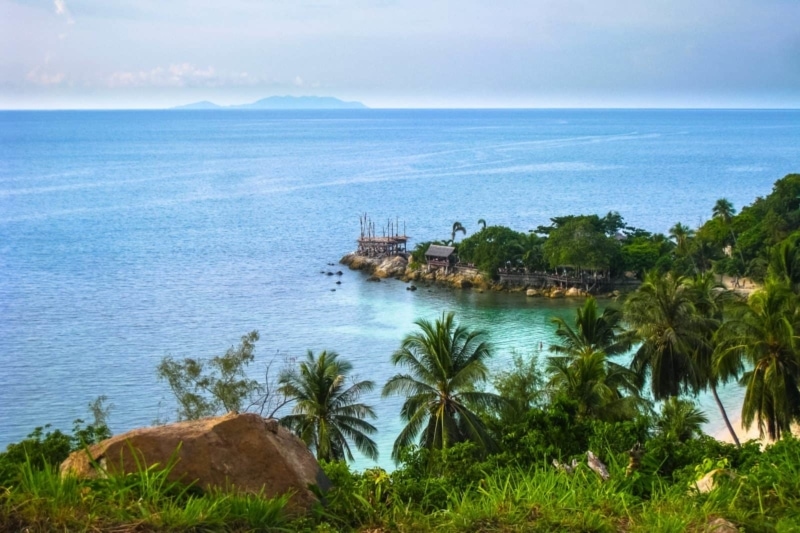
East Coast
Meanwhile, the East Coast’s Koh Phangan is home to the world famous Full Moon Party. This is not for everyone. It’s 30,000 people covered in neon paint drinking questionable concoctions from buckets on the beach. But for party-people, this is heaven.
If you’re not interested in the Full Moon Party, there are plenty of smaller parties on the islands, including the Half Moon Party and Lost in Paradise, among regular nightly beach parties with fire dancers.
You should also take the opportunity to get your PADI diving license on Koh Tao. It’s one of the cheapest places on the planet to do it and the diving there is unparalleled. Or, if you’d rather keep on terra firma, trek through the jungle to find the Na Muang Waterfall on Koh Samui.
Day 12-16: Kanchanaburi
Kanchanaburi is well known for its role in World War II. It is the site of the Death Railway, a tragic railroad that was built under Japanese orders to connect Thailand and Burma. The Japanese used prisoners of war and civilian laborers to construct the railway in hellish conditions. Malnourishment, tropical diseases and poor safety on site led to the deaths of over 100,000 people.
Nowadays, you can ride along the Railway from Kanchanaburi to Nam Tok and learn about the history of this region for an adventure through time.
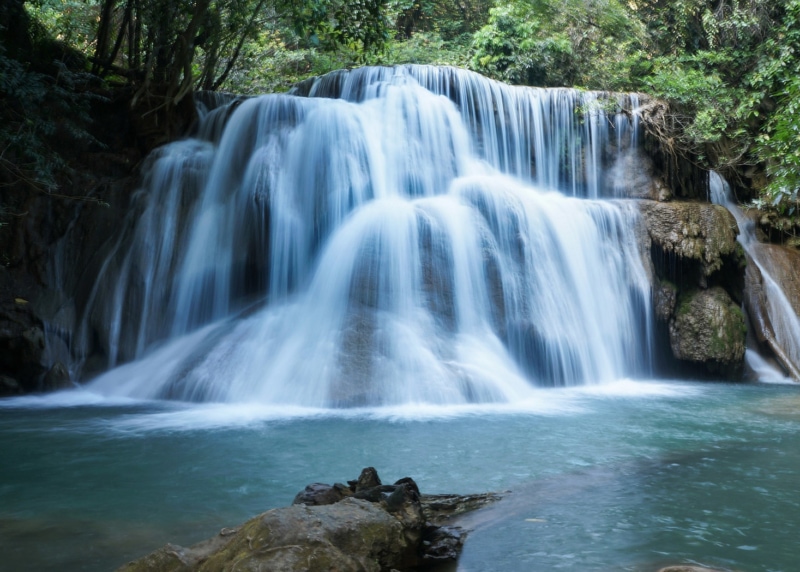
While you’re here, take a walk across the bridge over the River Kwai. From the bridge, there are beautiful views of the river and the floating accommodations that line its banks. Other popular activities worth doing include exploring the Erawan National Park, canoeing along the River Kwai, trekking through the jungle and bamboo rafting.
Day 17-22: Chiang Mai
As you meet people along your travels you will hear the same place muttered over and over again: Chiang Mai. It’s up north, but it makes the most sense to start working your way back north since the next country on your list, Laos, will be easier to enter up there.
So let’s start with Chiang Mai, a little city is a universal favorite with travelers and recognized as the digital nomad capital of the world.
In fact, you’ll meet a lot of Westerners in Chiang Mai who visited once years ago and never left. It is the kind of place that sucks you in and captivates you.
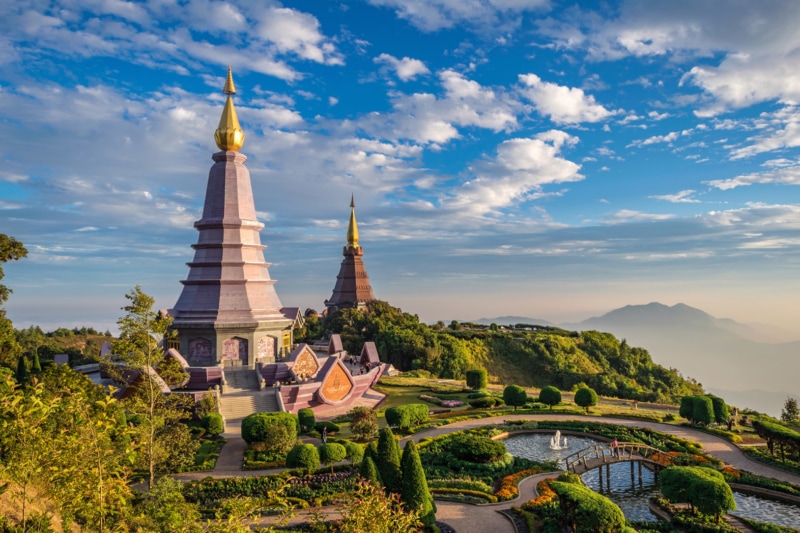
There is a lot to see and do in Chiang Mai and, because of its leisurely pace, you won’t want to rush. So, give yourself at least five days here.
Chiang Mai is the hub of adventure activities in Thailand. Here, you will find ziplining, jungle treks ATV riding and a whole lot more. These adventure tours are usually very reasonably priced and include transfers and lunch. In the evenings, head to the night bazaar in the city center and gorge on freshly cooked Thai street food.
For example, you could fly through the treetops and see the Mae Kampong Falls and, if you’re lucky, elusive wild gibbons. Or you could spend an entire day trekking up Doi Inthanon, Thailand’s tallest mountain.
Important Heads Up
If you want to spend time with elephants in Chiang Mai then do your research. While there are some legitimate elephant sanctuaries around, there are also a lot of sham sanctuaries (learn more about that here). Elephant Nature Park is the only rescue center that I can comfortably recommend, as it comes highly recommended by experts for its ethics and I’ve been there myself.
The same thing goes for Tiger sanctuaries. You might have seen people on Instagram posing with cuddly, subdued tigers. The tigers look this way because they have been drugged. Err on the side of caution and give the tigers a miss altogether if you don’t want to contribute to animal abuse.
Day 21-26: Pai
Pai is a quiet town in northern Thailand, which can be used as a base for trekking adventures. Northern Thailand is hill country covered with lush green grass and rice paddies. From Pai, you can take a day trip to the Mae Yen or Huay Chang Waterfalls or you can go for something more hardcore like a five-day trek through the entire region.
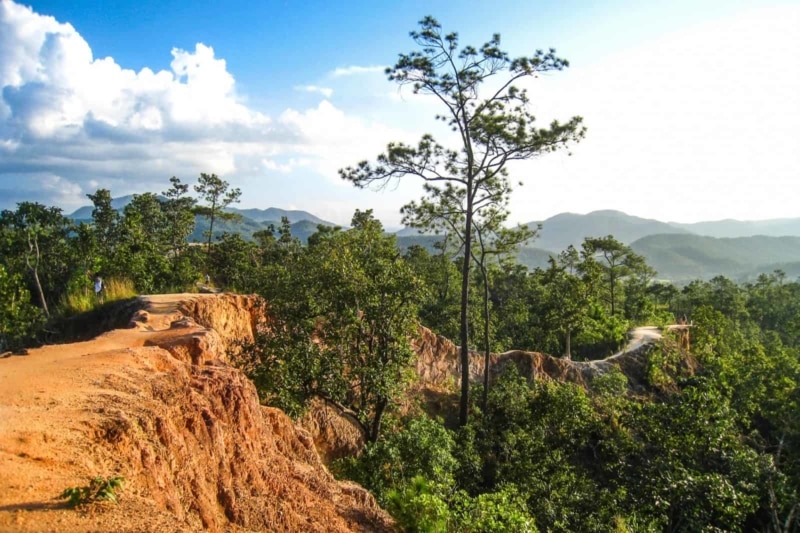
In the Huay Nam Dang National Park, Soppong and Mae Hong Son also have plenty of hiking routes to explore. If you have the stamina, there are multi-day treks in these areas, some of which include bamboo or white water rafting. While you’re trekking, you’ll have the chance to drop in to hill-tribe villages, small communes of Thais who still maintain a traditional way of living. Think straw huts and tribal outfits.
Day 27-30: Chiang Rai
As you make your way to Laos, make a brief stop in Chiang Rai It’s home to the exceptionally beautiful White Temple (Wat Rong Khun), an all-white, spiky building that looks like its made of icicles. It’s also surrounded by outstanding natural beauty—think tea plantations and rivers. Grab a bike and cycle around the area to get a taste for what life is like in this northern region.
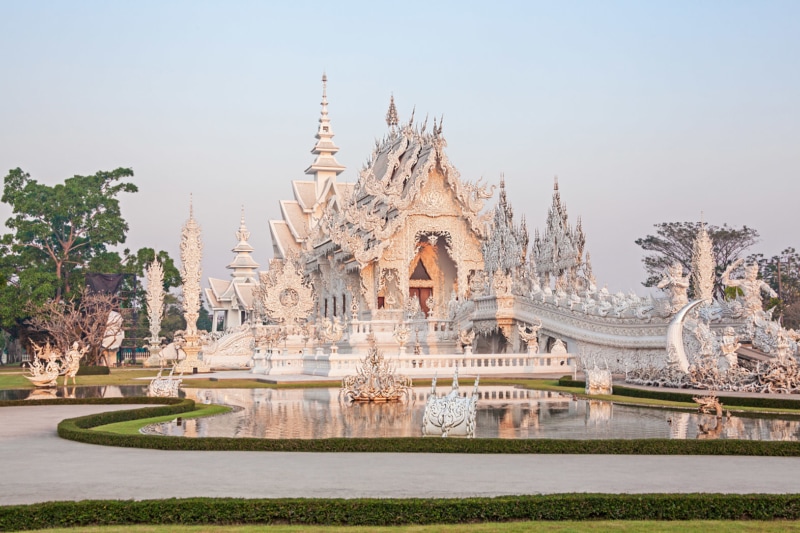
To immerse yourself fully in nature, there is a treetop walk that stretches through the sublime Mae Fah Luang Gardens in Doi Tung. You can share a taxi with others for about an hour ride from Chiang Rai, and you’ll find signs for the walk not far into the gardens. From the walk’s aerial vantage point, there are spectacular views of the gardens along with a mild adrenaline rush from being suspended 100 feet in the air.
When you’ve walked the whole route, come down and enjoy the gardens from ground level. Entrance to the garden and the treetop walk combined comes to around $7.
Laos: Two Weeks
From Thailand, Laos is just a hop, skip and a really long boat ride across the border. If you thought you had gotten used to Southeast Asia after a month in Thailand, think again. Laos is a whole new ball game and, while it might only be next door, you are still going to experience some culture shock when you arrive.
One thing you should know about Laos is that there are no trains. You will have to get around by bus, which would be fine, were the roads in Laos a little… better developed. It’s all part of the adventure and being jolted around in a bus for a few hours is a small price to pay to experience Laos.
To get from Thailand to Laos, you either need to sit on a boat for two days or in a minivan for 14 hours. Neither is ideal, but both will leave you with a handful of interesting stories.
Day 31-33: Vientiane
Compared to Bangkok, Vientiane is child’s play. It is quiet, easy-going and small. Despite the fact that it’s the capital, you really won’t need long here to cover the bulk of the city’s attractions. Once you’ve got your culture fix at the Museum of Lao Art, the Lao National Museum and the Wat Simuang Temple, head out to Vientiane’s outskirts for some nature.
Xieng Khuan, a meadow filled with Buddha statues,is a popular day trip from Vientiane. Otherwise, the Ang Nam Ngum Reservoir is an idyllic spot for camping, hiking and paddling around in boats. That’s the capital city covered.
Day 34-36: Vang Vieng
From Vientiane, head north in the direction of Vang Vieng. This once notorious backpacker hub is now a lot more chilled since tubing has been banned. The town is a ghost of its former self—that’s exactly why you should visit.
Nowadays, there are no more Chads chugging beers and wearing lurid vests. It’s peaceful, beautiful and tubing is still on the cards—it’s just way calmer than it used to be. Enjoy a beer as you float along the river and soak up the stunning views of the jungle around you.
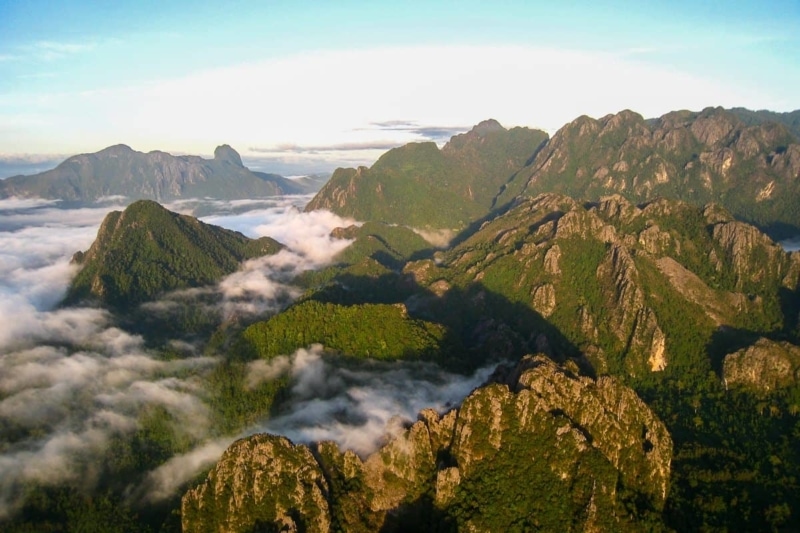
While you are in Vang Vieng you should go hot air ballooning (the photo above is all the convincing you ought to need). Also check out the Blue Lagoon and Cave. The water that feeds into this lagoon comes from the mountains and is a beautiful turquoise color. There are swings that hang from the trees over the lagoon.
Don’t forget to take a walk around the cave, too! All of these sites will be easy to visit by motorbike on your own or by setting up tours at your hostel or with travel companies in the center city.
Day 37-40: Luang Prabang
Deservedly on the UNESCO World Heritage list, Luang Prabang is a charming city in the northern part of Laos. A lot of people are tempted to miss out Luang Prabang because it is too far North. Don’t miss it out. It may well turn out to be your favorite place in Southeast Asia.
The number one sight in Luang Prabang is the stunning Kuang Si Waterfalls. You can swim at the top of these cascading falls that tumble into more tiered pools of crystal clear water. It’s best enjoyed visiting on your own, as opposed to going with a tour that’ll rush you through it. Consider renting a motorbike because it’s a relatively easy drive.
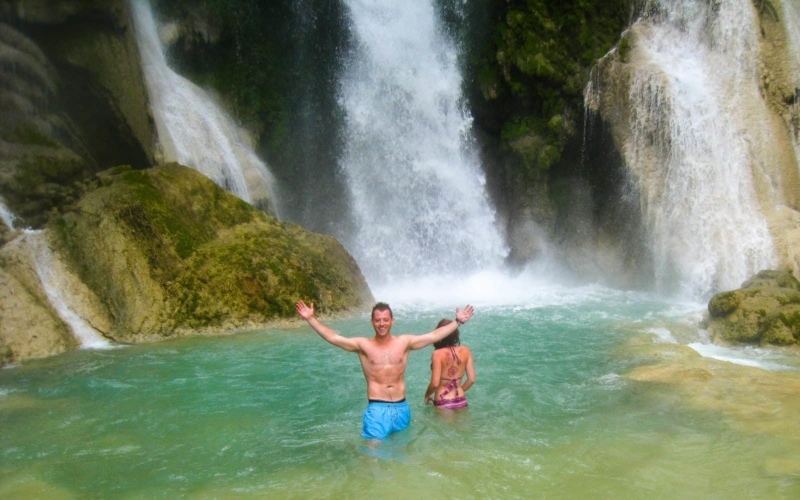
If you still have energy to expend after the waterfalls, you might want to climb the 355 steps to the top of Mount Phousi. OK, it’s not exactly a mountain, but the views from the top are insane. You’ll see the mighty Mekong and Nam Khan Rivers that carve through the vivid green scenery and the houses and huts that pepper the landscape.
Day 41-44: Phongsali
In the mountains of northern Laos sits Phongsali, the capital of Laos’ northernmost province. Although the town itself is reasonably large, you won’t find many other travelers here. If you were looking to get off the beaten path, this is the place to do it. By way of stimulation, there’s not a whole lot going on in Phongsali. But, that’s not why you came.
You come to Phongsali to breathe in the fresh mountain air, look at the stars at night and fall asleep to the cries of nature. And, above all, you come to Phongsali to trek. Set out on foot and explore the gorgeous scenery that flanks the town on all sides. Delve deep into the wilderness and seek out some of the secret hill-tribe villages.
BONUS: 4,000 Islands
If you happen to have more time in Laos because you opted to skip one of the above or you’d spent less time than you anticipated in one of them, you should check out the 4,000 Islands. You can catch an overnight bus to the 4,000 Islands from most major cities like Vientiane or Vang Vieng.
The overnight buses will take you to a town called Pakse, where you’ll have to catch another tourist bus to the port to the islands in Ban Nakasong. It’s about a three-hour journey. Once you’re there, you can decide between Don Det or Don Khong, connected via a bridge.
I recommend checking out both Don Det and Don Khong if you have the time. Don Det offers higher-end guesthouses and attracts an older crowd. But it boasts the beautifully cascading Liphi Waterfalls, where you can spot fresh-water dolphins.
Don Khong is the biggest of the 4,000 islands and is a sleepy hippie haven peppered with hostels and inexpensive guesthouses. It has tons of riverfront bars and restaurants, too.
Vietnam: Three Weeks
Just when you thought you’d adjusted to the lazy pace of Laos, it’s time to shake things up again. Welcome to Vietnam. Despite still bearing the visible scars of its conflict with the US, Vietnam is a thriving country with modern cities.
I’ll admit, one thing that plagued me before I touched down in Vietnam was how the Vietnamese would treat me given the fact that I’m American. Honestly, I had no problems.
The older generation occasionally gave me disapproving looks but, as a whole, people were super friendly—especially young people. Just try not to be too American while you’re there, if you get what I mean.
Vietnam is the perfect mixture of urban and rural, and it’s teeming with man-made and natural beauty. There’s a lot to see in this country and, in three weeks, you’ll barely scratch the surface. But, that’s all the more reason to go back someday.
Day 45-47: Sapa
Your first stop on your journey through this beautiful and historically fascinating country will be Sapa. It will also, most likely, be your most beautiful stop. But, be aware that the climate in Sapa is a lot cooler than what you’ve experienced so far due to the altitude. Wrap up warm and bring some waterproofs.
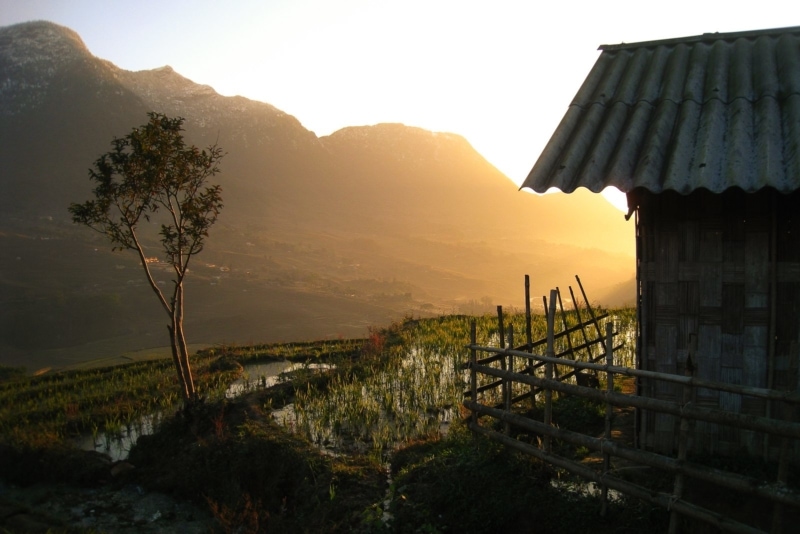
As you emerge from the fog that often blankets Sapa, the world will suddenly be tinged with green. Terraced rice paddies sit one on top of the other, verdant and pristine. This is what happens when people work in tandem with Mother Nature. Spend your time here trekking through hill-tribe villages and dosing up on fresh, clean air.
Day 48-51: Hanoi
Home to over four million motorcycles, Hanoi thrums with energy and simply crossing the road is an adventure in itself. It’s Vietnam’s capital city and is, in itself, a historical relic.
Yet, while the streets are chaotic, the parks and plaza are oddly serene. French style architecture can be found throughout the city, as well as bakeries selling French pastries—remnants from their colonial rule.
Take it slow in Hanoi. Hire a bike and cycle around the Hoan Kiem Lake, or just walk if you don’t trust yourself on two wheels near a body of water. Cross the bridge that leads to the middle of the lake and visit the temple there. I also recommend paying your respects at Ho Chi Minh’s Mausoleum, an impressive building fit for such a respected military leader.
Day 52-53: Halong Bay
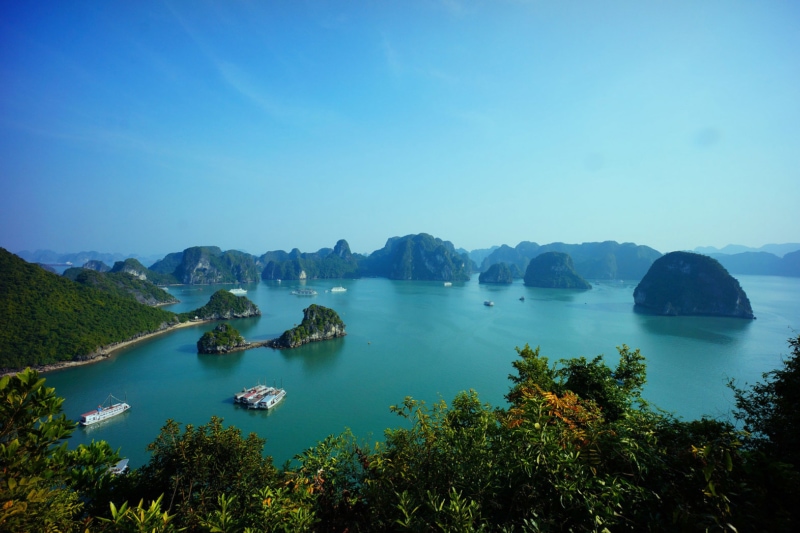
Pretty much everyone who goes to Vietnam goes on a cruise of Halong Bay. While I usually advocate avoiding places heaving with tourists, Halong Bay is an exception.
Boat tours go out in the bay for days at a time, laden with adventurers who want to admire the pinnacles up close. If somehow you haven’t already seen photos of Halong Bay, it consists of dozens of jagged green islands that plunge up out of the water. Each island has sheer walls densely covered with vegetation and the whole place has a prehistoric feel to it.
There’s not much to do here other than sitting on a boat and enjoy yourself. You can sign up with Halong Bay tours through your hostel, which I recommend over sometimes dodgy and overpriced tour companies in the city.
Day 54-56: Hoi An
Head a little further south and you’ll hit Hoi An. Most people will take the train to Danang and a cab from there, but there are also minivans that pass through the Hai Van Tunnel. This is the longest tunnel in Southeast Asia, stretching a staggering four miles.
Once you arrive in Hoi An, you are likely to be approached straight away by someone trying to sell you custom-made clothes. Hoi An is the tailoring capital of Vietnam and, if you were looking to get a bespoke suit or dress made for a fraction of what you would pay back home, you need look no further.
Strolling through Hoi An, you’ll encounter the Japanese Bridge, the Fukian Assembly Hall and lots of beautiful, old buildings. I recommend hiring a bike for a couple of dollars and cycling through the city and out into the rice paddies. Again, motorbikes are easy to rent here and the freedom is worth the extra money for a few days.
Day 57-60: Nha Trang
Nha Trang is the most popular beach spot in Vietnam. Given that you haven’t been on the beach since the Thai Islands over a month ago, you should treat yourself to a bit of sea and sand here. A few days is all you need to check out the highlights and top up on your tan before you carry on your journey through Vietnam.
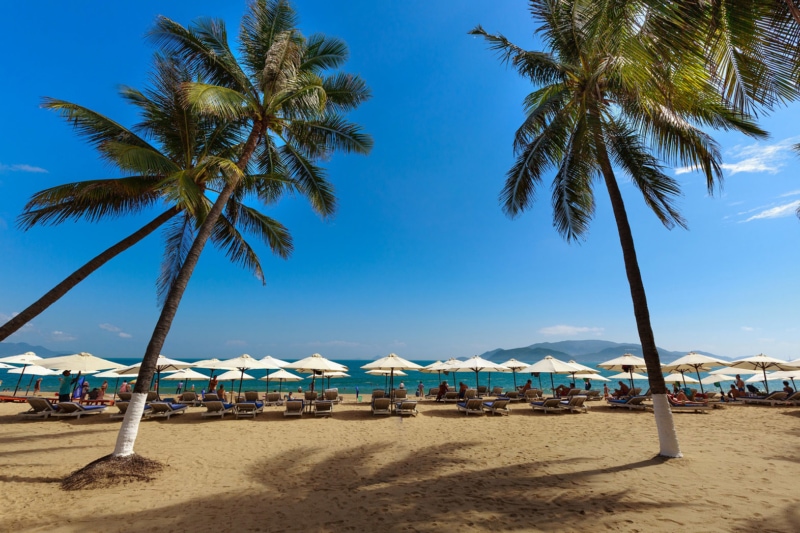
You’ll notice a lot of dive shops all over Nha Trang. The diving here is excellent and the prices are reasonable. Whether you’re a qualified Dive Master or have never so much as seen an oxygen tank before, you should spend a morning diving here.
Now, this is a bit of a guilty pleasure but, after months of temples and cultures, it is certainly justified. In Nha Trang you will find Vinpearl, one of Southeast Asia’s premier theme parks. Sitting on its own little island, the park has a safari, water park, golf resort, spa and just about anything else you could think of.
Theme parks may not be the most culturally enlightening experience, but whoever said travel had to be all about culture? This is guaranteed to be a day of seriously good fun.
Day 61-62: Mui Ne
Mui Ne is the driest place in Southeast Asia. Although the region is just four hours by train from Ho Chi Minh City, it feels like you’ve just been transported out to the Sahara. You only need a day here to experience it; it really is just sand dunes as far as the eye can see.
Visiting Mui Ne is worth it though. Get up at the crack of dawn and watch the sunrise over the dunes. Then rev up a quad bike and prepare for action. Racing around these dunes is a cool experience that will get the adrenaline pumping before breakfast.
Day 63-66: Ho Chi Minh City
Finally, you’ve made it right down to the bottom of Vietnam, to the commercial hub of the country: Ho Chi Minh City. You might be more familiar with the city’s previous name, Saigon. During the Vietnam War, this city played a pivotal role in the military developments and eventually fell to the communists, ending the war entirely.
The city is an interesting mixture of old and new, with modern business centers sitting side by side with colonial churches. The post office in downtown Ho Chi Minh City is one of the best-preserved examples of colonial architecture.
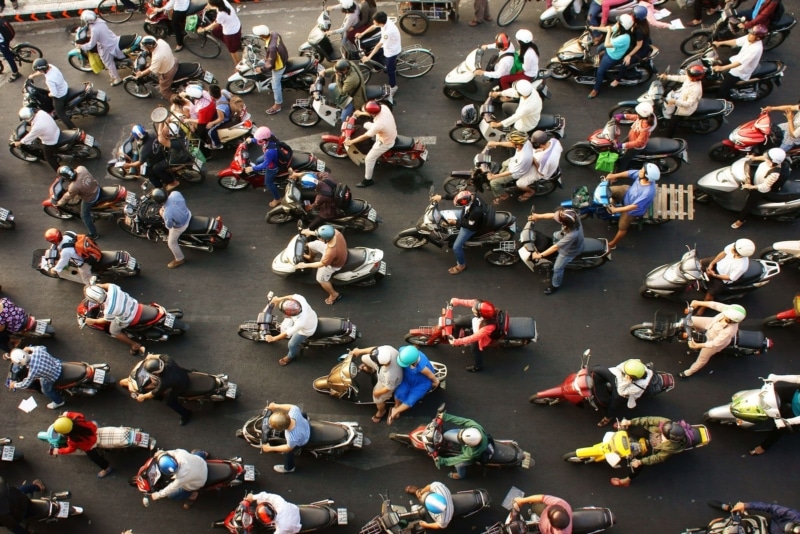
To get a taste of HCMC’s history, check out the War Remnants Museum. Getting to see the Vietnamese perspective of that notorious war is both interesting and valuable.
When you’re ready for adventure, leave the city and travel to the Mekong Delta for a day. Here, you can float along the river, explore floating markets and even try your hand at fishing.
Cambodia: Three Weeks
Your final country on your journey through Southeast Asia is Cambodia. Yet again, you’re going to need to readjust to a completely different culture. Vietnam and Cambodia might be neighbors, but they are startlingly different.
Cambodia moves at a slower pace to its neighbors and it is noticeably less developed. Just like in Laos, your primary modes of transport here are going to be buses, minivans and, this time, tuk-tuks. But, don’t worry, everywhere in Cambodia is well connected and, given that it is such a compact country, it’s reasonably easy to pack a lot into three weeks.
Day 67-70: Phnom Penh
For a capital city, Phnom Penh will seem exceptionally quiet. There are no crowded freeways or mega-malls with glitzy billboards like in Bangkok. Instead, you’ll find dirt roads laden with street vendors and tuk-tuks, and rickety shacks filled with local snacks (and Oreos—you can find Oreos everywhere).
Phnom Penh has a turbulent past. The year 1979 marked the end of Pol Pot’s bloody dictatorship that ordered a systematic genocide of the Khmer people. The regime slaughtered an estimated three million people.
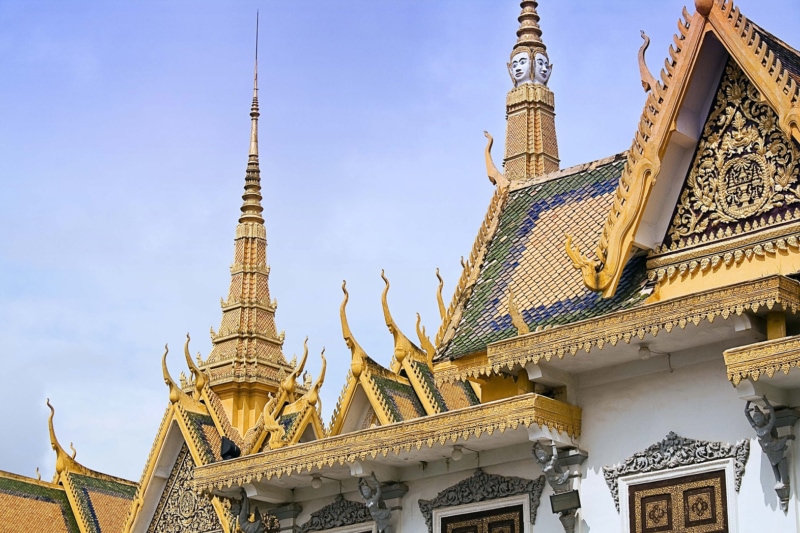
The Tuol Sleng Killing Fields Museum and the Killing Fields are two important sites for those wishing to understand more about Pol Pot’s regime.
Tuol Sleng, a former high school turned concentration camp, is still in the exact state it was when the Vietnamese liberated Cambodia. It is a macabre and harrowing place to visit, but it’s worth the trip to understand just how brutal Cambodia’s dictatorship was.
Even if you’re not a history buff, the genocide was relatively recent and most Cambodians living today have lost family and friends during it. Understanding what happened will help you to understand the country and its people living today, too.
Day 71-74: Kampot
Kampot is where people come to kick back and relax. But, there are still activities on offer if you’ve got itchy feet. Or hire a kayak for the day and paddle through the mangroves and tributaries of the Kampot River.
As you move along the water, you’ll catch a glimpse of life on the banks of the river. For the rural villages that flank that waterway, the Kampot River is a lifeblood around which they have built their lifestyle. Then simply stroll or cycle through the town and along the edge of the water. Nothing moves fast here so neither should you.
Day 75-80: Sihanoukville & Koh Rong
Time for some more beach—and this time it will be even cheaper than anything you’ve experienced before. In Sihanoukville you can live like royalty for less than $20 each day. Cambodia might not have much of a coastline, but what it does have will blow you away.
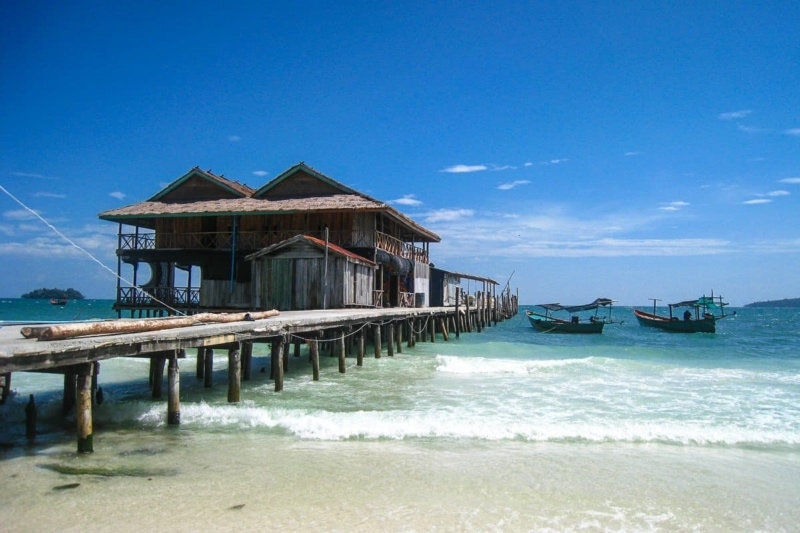
Not keen on lying on the beach all day? Watersports are the main attraction for thrill-seekers in this part of the country. Diving, windsurfing and kitesurfing are all on the menu here. Fortunately, the water there is delightfully warm so you don’t need to squeeze yourself into a wetsuit if you don’t want to.
While here, be sure to spend at least a few days on the island of Koh Rong. Far less developed than the Thai islands, Koh Rong still has an element of wild about it. Sure, there are bars and resorts, but there are also patches of untouched natural beauty and utter tranquility.
Day 81-83: Battambang
Also known as Cambodia’s rice bowl, Battambang is a photographer’s mecca. That is, if you go to the right places. Less than 7.5 miles out of town is Phnom Sampeau, a large hill with a temple on top. The temple itself is nothing to write home about. But turn 180 degrees and there are magnificent views of the rice fields. They’re green as far as the eye can see.
Phnom Sampeau is also home to more sobering sites, including the Killing Caves. Just as the name suggests, these caves saw the deaths of thousands of regime dissenters during Pol Pot’s rule. Not for the faint-hearted, the caves display the skulls of hundreds of victims who’d lost their lives here.
If the Killing Caves are too chilling to experience, the nearby Bat Cave should be a more light-hearted experience. In the evening, hundreds of bats fly from the caves in what is quite an astonishing natural spectacle. Once they are all out of the cave, you are free to go in and explore.
Day 84-86: Tonle Sap Lake
The Tonle Sap Lake is the largest of its kind in Southeast Asia. It’s depended on by over a million Cambodians. In fact, it’s the lifeline for some Cambodians, who bathe in, use it as a bathroom, illegally fish in it, wash their dishes and clothes in it, and even drink from it. At the level of poverty that hits Tonle Sap Lake.
There are tours that’ll allow you to hop in a canoe and float through the stilted villages that sit on top of the water (read about my experience doing just that here), but I recommend only visiting to educate yourself —don’t contribute to poverty tourism in Asia.
Of course, part of the adventure is to learn about how other people live. But remember: These people’s home are essentially on display for tourists who travel to Cambodia, an incredible luxury that many of them will never be afforded.
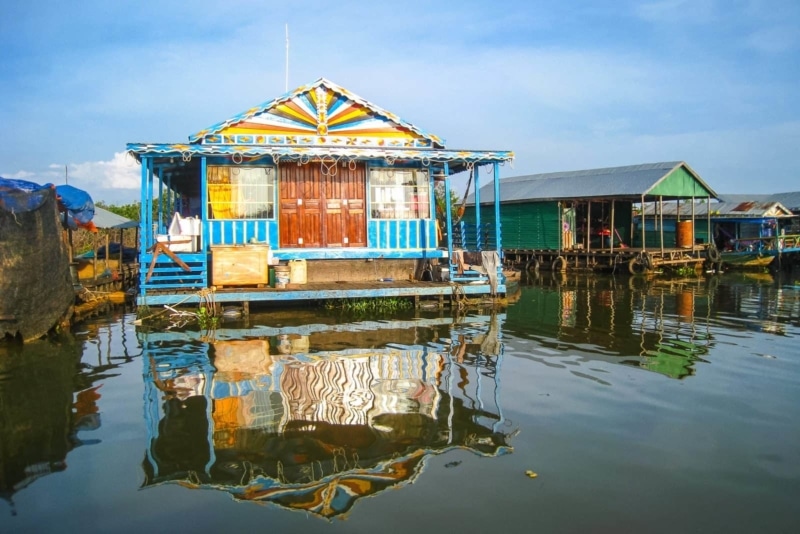
Day 87-90: Siem Reap
Wow. After three months of adventure in Southeast Asia you have finally come to your last stop—and, what a way to end the trip. Siem Reap is home to, among other things, the most famous collection of ruins in Asia, and possibly the world: Angkor Wat.
The Cambodians built it somewhere between A.D. 1113 and 1150, and about two million people visit to revel in its storied history each year.
There’s a lot to learn about this temple, dubbed the most spiritual temple in the world. Originally a Hindu temple, the Cambodian’s dedicated this one to the god Vishnu, and they added Buddha effigies in the 14th century.
People also generally accept that Angkor Wat was a funerary temple for King Suryavarman II, who built it to mark the capital of the Khmer Empire as his state temple and eventual mausoleum.
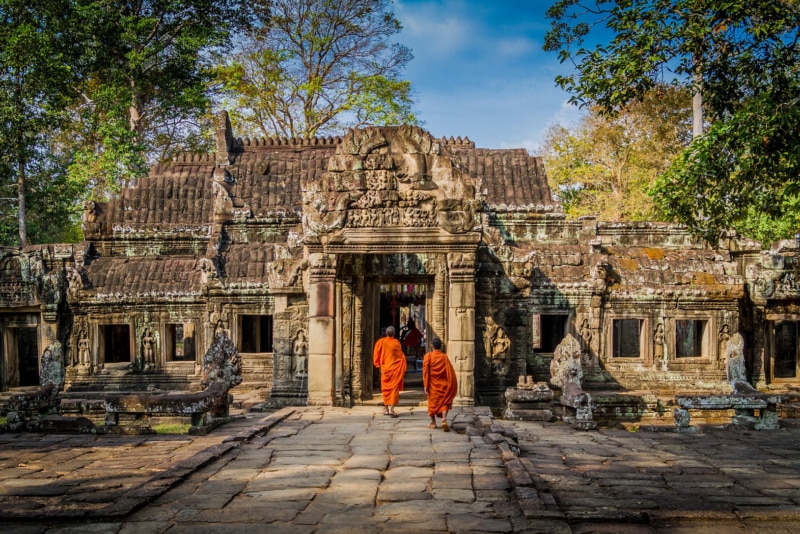
Some people just spend a day at Angkor Wat. I wholeheartedly advise you to dedicate at least two days to it though. You need it to really understand its magnitude.
If you visit for just the sunset around 5 p.m., you can get in for free. Then use your ticket again for the following day. But you must get your ticket from an office a short drive away from the temple itself. Make sure you buy your ticket before heading to the temple.
While sunset is gorgeous, sunrise at Angkor Wat is famous for a reason. On day one, get up while it’s still dark and make your way to the temple complex. Get there in time to see the sunrise over Angkor Wat and the lily lake. It’s a phenomenal sight
Spend the rest of the day and the following day exploring the dozens of temples.
Cambodian Temples to Visit
- Bayon: Fifty-four gigantic stone faces with creepy smiles fill the Khmer temple. Architects built it in the late 12th or early 13th century. It was the official state temple of the Mahayana Buddhist King Jayavarman VII.
- Ta Phrom: Architects built it in the Bayon style in the late 12th and early 13th century. Today, thick tree roots cover it, and it was the set of the film, Tomb Raider.
- Banteay Srei: Dedicated to the Hindu god Shiva is this 10th-century temple. Intricate, beautiful carvings decorate it.
- Preah Khan: Architects built this one in the 12th century for King Jayavarman VII to honor his father. Today’s it’s one of the largest and least-restored temples.
And that concludes your journey through Southeast Asia. You’ll make your way back to Suvarnabhumi Airport in Bangkok and fly home from there. As the international hub of Southeast Asia, this is where you’ll find the cheapest flights.
And while this itinerary is detailed, remember that it should only be used as a guideline. Part of the beauty of backpacking through Southeast Asia is having the freedom to be spontaneous.
If you want to take a detour via a temple you’ve heard about, do it. If a national park keeps getting recommended to you by other travelers, see it!
After all, that’s what adventure is all about.
Let us know in the comments what you’re most excited about!
Southeast Asia Itinerary FAQs
-
How long do you need to travel Southeast Asia?
You can take anywhere from a week to several months to travel Southeast Asia.
-
How much should I budget for 4 weeks in Southeast Asia?
You should be able to spend 4 weeks in Southeast Asia for around $1500.
-
What is the cheapest country in Southeast Asia?
Thailand is one of the cheapest countries in Southeast Asia.
-
Is Southeast Asia cheaper than Mexico?
Southeast Asia is cheaper than Mexico overall. However, some cities (like Singapore) will be more expensive.
-
What is the most underrated country in Southeast Asia?
Cambodia is one of the most underrated countries in Southeast Asia.
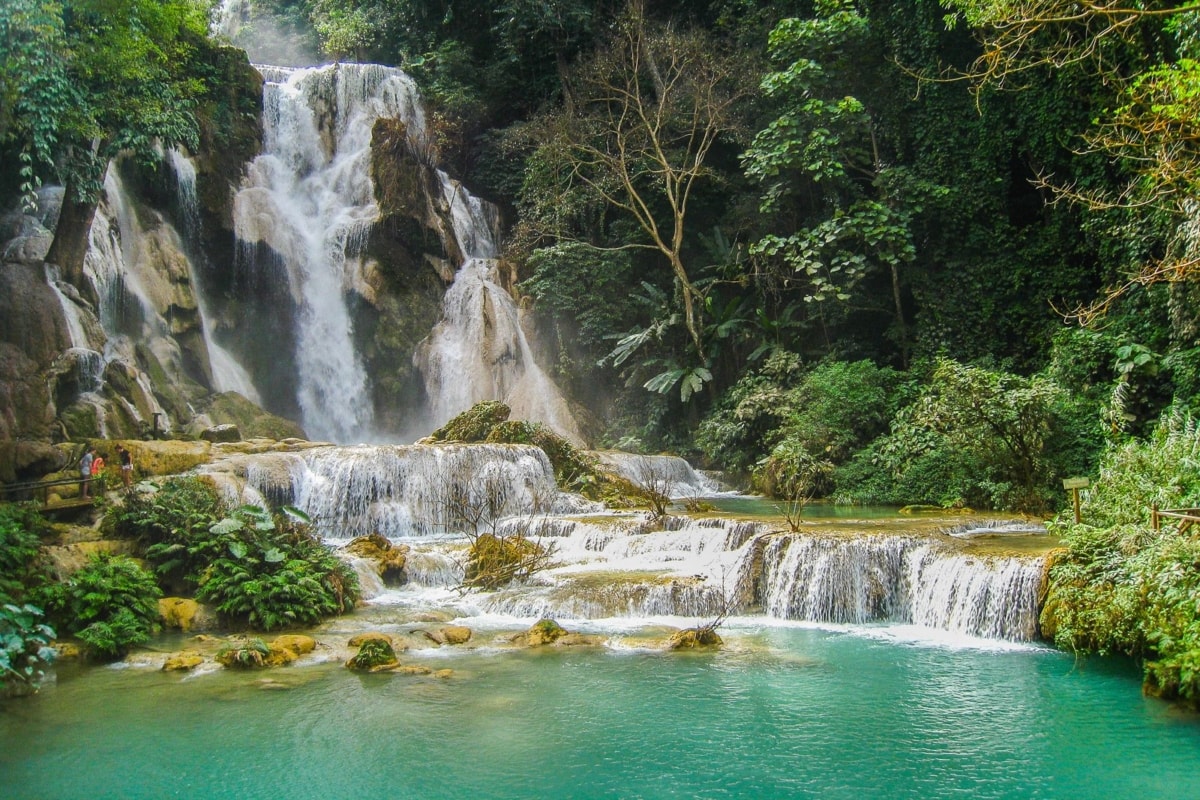

Wow, this itinerary is so comprehensive! Is it based on your own trip? I wish I had done something like this! I mean backpacking Southeast Asia for 3 months 🙂 But at least I saw parts of Thailand and Cambodia. The other 2 are still on my to-go list.
Hi Jeremy, Jules Verne wrote “Around the World in 80 Days” and you wrote in 90 Days; hahaha! However, your post was really informative and I just loved to read. Maybe I’ll try once to discover the world in 90 days!
I have been to Vietnam, I feel this place is wonderful to come back again. how to make slime
So many great places to visit in SEA, and they each have their own unique culture.
I also like to take better advantage of each place I go, and one thing I’ve been trying to do is really policing myself to take better care of my finances and to be more selective in every place I decide to visit and get to know in a city or country. Because since we are long-term travelers it is easy to end up having unnecessary expenses and this post helped me to reflect on the importance of this. Thanks for sharing your experience the Asian region with us Jeremy 🙂
Wow what a cool place .. I even gave it a try to take a tour in this region. I have been looking for places like this here in the Country that I am going through but I have not yet found. Thanks for the tip. I’ll take a closer look at who knows the Asian places too.
Amazing itinerary!! I know its hard to give an accurate answer but could you give an estimated budget for this trip? Excluding international flights of course! Thanks in advance…
Southeast Asia can definitely be done for $1k/mo if you’re on a budget. It all depends on the types of places you stay and where you eat. Hostels and street food vendors are your best friends!